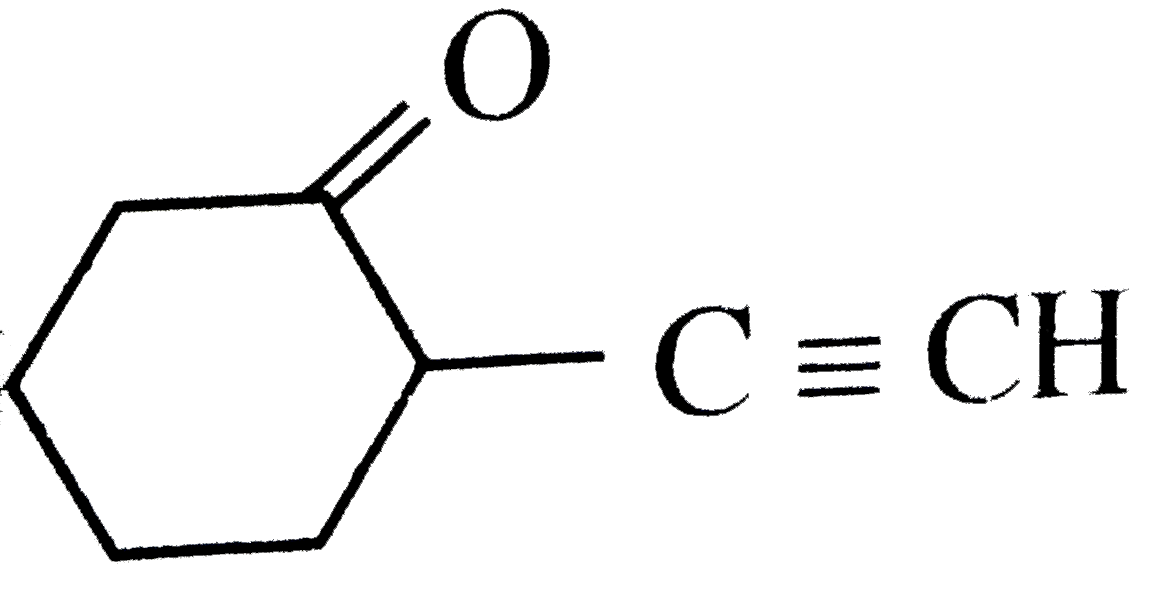C4H6H2+Pt−−−−→1molC4H8O3/H2O−−−−→ Acedic acid
(A) and (B), respectively, are:




The correct Answer is:A, C
To solve the problem, we need to identify the compounds A and B based on the given reactions and molecular formulas.
1. Identify the Structure of Compound A (C₄H₆):
- The molecular formula C₄H₆ indicates that the compound is an alkyne or a diene due to the unsaturation (fewer hydrogens than alkanes).
- The possible structures for C₄H₆ include 1-butyne (CH₃C≡CCH₃) or 1,3-butadiene (CH₂=CH-CH=CH₂).
- Since we are looking for a compound that can undergo hydrogenation (addition of H₂), we can consider 1,3-butadiene as a likely candidate.
2. Reaction of A with H₂ and Pt:
- When 1,3-butadiene reacts with H₂ in the presence of platinum (Pt), it undergoes hydrogenation.
- This reaction will result in the formation of 1-butene (C₄H₈) through the addition of hydrogen across the double bonds.
3. Identify Compound B (C₄H₈):
- The product of the hydrogenation, 1-butene (C₄H₈), can further react with ozone (O₃) followed by hydrolysis (H₂O).
- Ozonolysis of 1-butene will lead to the formation of two molecules of acetic acid (CH₃COOH).
4. Final Identification:
- Therefore, compound A is 1,3-butadiene (C₄H₆) and compound B is 1-butene (C₄H₈).
- The ozonolysis of 1-butene produces acetic acid (CH₃COOH).
Summary:
- A (C₄H₆) = 1,3-butadiene
- B (C₄H₈) = 1-butene
- The molecular formula C₄H₆ indicates that the compound is an alkyne or a diene due to the unsaturation (fewer hydrogens than alkanes).
- The possible structures for C₄H₆ include 1-butyne (CH₃C≡CCH₃) or 1,3-butadiene (CH₂=CH-CH=CH₂).
- Since we are looking for a compound that can undergo hydrogenation (addition of H₂), we can consider 1,3-butadiene as a likely candidate.
- When 1,3-butadiene reacts with H₂ in the presence of platinum (Pt), it undergoes hydrogenation.
- This reaction will result in the formation of 1-butene (C₄H₈) through the addition of hydrogen across the double bonds.
- The product of the hydrogenation, 1-butene (C₄H₈), can further react with ozone (O₃) followed by hydrolysis (H₂O).
- Ozonolysis of 1-butene will lead to the formation of two molecules of acetic acid (CH₃COOH).
- Therefore, compound A is 1,3-butadiene (C₄H₆) and compound B is 1-butene (C₄H₈).
- The ozonolysis of 1-butene produces acetic acid (CH₃COOH).
- A (C₄H₆) = 1,3-butadiene
- B (C₄H₈) = 1-butene
Topper's Solved these Questions
- ALKYNESBOOK - CENGAGE CHEMISTRY ENGLISHCHAPTER - ALKYNESEXERCISE - Exercises (Single Correct Answers Type)
30 Videos
- ALKYNESBOOK - CENGAGE CHEMISTRY ENGLISHCHAPTER - ALKYNESEXERCISE - Exercises (Archives - Single Correct Answer Type)
6 Videos
- ALKYNESBOOK - CENGAGE CHEMISTRY ENGLISHCHAPTER - ALKYNESEXERCISE - Exercises (Linked Comprehension Type)
51 Videos
- ALKENES AND ALKADIENESBOOK - CENGAGE CHEMISTRY ENGLISHCHAPTER - ALKENES AND ALKADIENESEXERCISE - Single correct Answer
14 Videos
- APPENDIX - INORGANIC VOLUME 1BOOK - CENGAGE CHEMISTRY ENGLISHCHAPTER - APPENDIX - INORGANIC VOLUME 1EXERCISE - chapter-7 Single correct answer
1 Videos
Similar Questions
CH3−C≡NH2O/Δ−−−−→(A)H2O/H+−−−−−→(B)(A)and(B) respectively are
View SolutionIn the reaction sequence
C6H5CHONH2OH/H⊕−−−−−−−−→Δ(X)P2O5/Δ−−−−−→(Y)H2O,H+−−−−−→(Z)
(X), (Y) and (Z) respectively be
View Solution
Conc. H2SO4−−−−−−−−→BO3/H2O/Zn−−−−−−−→C. A, B and C are -
View SolutionC8H10O3,H2O−−−−→C4H6O2 Acid (B), Identify (A) and (B) in the above reaction
View SolutionA(C4H6)H2,Li−−−→1moleB(C4H8)1.O3−−−−−→2H2O/ZnCH3CHO Thus A and B are :
View SolutionWrite the product of following reactions :
(a) CH3−H3C∣C=CH3∣C−CH3O3−−−−−→Zn/H2O , (b) CH3−C≡C−CH3O3−−−−−→Zn/H2O
( c) CH3−C≡C−CH3O3/H2O2−−−−−→ , (d) CH3−CH3∣C=CH−CH3O3/H2O2−−−−−→
View SolutionC2H2Hg(OH)21%−−−−−−−−−−→H2SO4A[O]−−→B, B is :
View SolutionC6H5NH2NaNO2/HCI−−−−−−−−→0∘C(A)H3PO2/H2O−−−−−−−→(B) the compound (B ) is :
View Solution
∣HgSO4/H2SO4−−−−−−−−−−→(A)2molofMeMgBr/H3O⊕−−−−−−−−−−−−−−→(B). (B) is :
View SolutionWhich of the statements are correct?
R−≡−RH2+P−2−−−−−→Catalyst(A)MMPP−−−−→(B)H+/H2O−−−−−→+(C)

(D)MMPP−−−−→(E)H+/H2O−−−−−→(F)
View Solution
